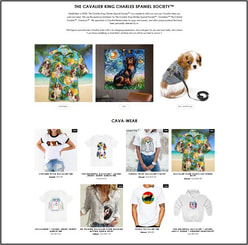ROYAL FLUSH CAVALIERS
THE CROWN BREEDER OF CAVALIERS TM
Email: [email protected] * Phone: 401.213.6333
OUR ONLINE STORES
Every item within our stores is an expression of our devotion to the breed and commitment to our valued clients. Informed by our personal experiences and expertise, we have curated a collection of products that align with our established practices. From beautiful bedding to fun accessories and health conscious grooming essentials, each product bears the imprint of our love for all things Cavalier. Feel free to explore our stores, and shop to your heart's content or to use as a guide and glean valuable insights to everything you'll need for your new puppy.
GROOMING YOUR CAVALIER KING CHARLES SPANIEL
Maintaining the pristine look of your Cavalier King Charles Spaniel involves consistent bathing and grooming. Seeking guidance on how to enhance their appearance? Valuable grooming insights await you right here!
The Cavalier boasts a medium length, undulating coat. For show presentation, the coat (except for the paws) cannot be clipped, underscoring the importance of daily brushing to avert the tangles that can plague its plush, silky fur. With characteristic feathering on the chest, ears, legs, feet, and tail, regular baths are indispensable to preserve the overall allure of both the feathering and the dense coat.
BRUSHING
To maintain the radiance of your Cavalier King Charles Spaniel, a daily routine of brushing using a medium bristle brush works best. This practice stimulates the skin and distributes natural oils through the coat. A slicker brush is your tool to prevent and remove knots and tangles. Dedicate special attention to the extended, feathery segments of the coat, particularly the ears, hind legs, and the area beneath the tail, where tangling is prone.
Even the paws of the Cavalier require brushing to keep their voluminous appearance. The Cavalier's foot hair remains untouched by trimming; brushing serves as a deterrent against matting. Ensuring the Cavalier's ease of movement, especially on sleek surfaces, hinges on detangling the hair on their feet and between the toes. Because the breed features both an outer and undercoat, remember to lift the outer layer to access the underlying hair while brushing. Before bathing, a thorough brush through is necessary to eliminate tangles that worsen when wet.
BATHING
The water resistant quality of the Cavalier King Charles Spaniel's natural coat is attributable to the undercoat's oils. Achieving thorough cleansing means a dual shampoo process: the first to break down oils, followed by the second to remove them. Due to the oil removal during bathing, exceeding a monthly wash is discouraged to prevent skin dryness.
Start with lukewarm water to dampen the coat, followed by lathering with a good quality shampoo. Thorough rinsing is crucial, as is repeating the process. Post second wash, diligently apply dog conditioner according to instructions, ensuring a thorough rinse. Adequate rinsing prevents potential skin irritation. For soap removal, consider using a sink sprayer for best results. When bathing, take care to avoid introducing soap or conditioner to the dog's face. Instead, use a moistened washcloth to clean facial regions and remove tear stains using specialized pet wipes available at pet supply stores.
DRYING
Start the drying process by gently blotting your Cavalier's coat with a towel, minimizing the risk of water dispersion through shaking. Avoid vigorous rubbing, which can contribute to tangling. Use the lowest hairdryer setting to dry the coat, and a medium bristle brush to fluff the fur, particularly in feathery regions like the ears. This approach not only enhances the coat's fullness but also mitigates potential skin issues stemming from residual dampness.
EAR CARE
The drooping, velvety ears of the Cavalier King Charles Spaniel create an ideal environment for moisture related infections. A weekly regimen of using dog ear cleaning solution and cotton balls serves to cleanse the ears and eliminate any waxy buildup. Regularly inspect the ears for odorous signs of fungal or bacterial infections. Consult a veterinarian if symptoms of an ear infection arise. If you’re not headed to the shows, trimming the ear flap's interior hair enhances airflow, minimizing infection risks.
FEET TRIMMING
The Cavalier's feet bear beautiful, feathered fur that surpasses other coat regions in length. To ensure the best movement, the American Kennel Club recommends hair trimming between the paw pads, but not elsewhere. You can use electric clippers or hire a professional groomer to perform this task. Regularly check the feet for debris or entangled hair on the upper surface, using a slicker brush for removal. For nail trimming, opt for professional assistance to avoid the cutting of the quick, which can cause pain and bleeding.
CLIPPING
Clipping the coat is not permissible for show purposes with Cavalier King Charles Spaniels. For non show dogs, a puppy cut (a uniform fur reduction to about an inch in length), can simplify grooming. Be advised that might result in thicker, curlier regrowth, necessitating recurrent future clippings.
GROOMING RITUALS
Given the Cavalier's penchant for lap lounging, use this to your advantage during grooming. Wait until the dog settles onto your lap before you start brushing. Encourage grooming sessions with positive reinforcement through treats and praise.
Maintaining the pristine look of your Cavalier King Charles Spaniel involves consistent bathing and grooming. Seeking guidance on how to enhance their appearance? Valuable grooming insights await you right here!
The Cavalier boasts a medium length, undulating coat. For show presentation, the coat (except for the paws) cannot be clipped, underscoring the importance of daily brushing to avert the tangles that can plague its plush, silky fur. With characteristic feathering on the chest, ears, legs, feet, and tail, regular baths are indispensable to preserve the overall allure of both the feathering and the dense coat.
BRUSHING
To maintain the radiance of your Cavalier King Charles Spaniel, a daily routine of brushing using a medium bristle brush works best. This practice stimulates the skin and distributes natural oils through the coat. A slicker brush is your tool to prevent and remove knots and tangles. Dedicate special attention to the extended, feathery segments of the coat, particularly the ears, hind legs, and the area beneath the tail, where tangling is prone.
Even the paws of the Cavalier require brushing to keep their voluminous appearance. The Cavalier's foot hair remains untouched by trimming; brushing serves as a deterrent against matting. Ensuring the Cavalier's ease of movement, especially on sleek surfaces, hinges on detangling the hair on their feet and between the toes. Because the breed features both an outer and undercoat, remember to lift the outer layer to access the underlying hair while brushing. Before bathing, a thorough brush through is necessary to eliminate tangles that worsen when wet.
BATHING
The water resistant quality of the Cavalier King Charles Spaniel's natural coat is attributable to the undercoat's oils. Achieving thorough cleansing means a dual shampoo process: the first to break down oils, followed by the second to remove them. Due to the oil removal during bathing, exceeding a monthly wash is discouraged to prevent skin dryness.
Start with lukewarm water to dampen the coat, followed by lathering with a good quality shampoo. Thorough rinsing is crucial, as is repeating the process. Post second wash, diligently apply dog conditioner according to instructions, ensuring a thorough rinse. Adequate rinsing prevents potential skin irritation. For soap removal, consider using a sink sprayer for best results. When bathing, take care to avoid introducing soap or conditioner to the dog's face. Instead, use a moistened washcloth to clean facial regions and remove tear stains using specialized pet wipes available at pet supply stores.
DRYING
Start the drying process by gently blotting your Cavalier's coat with a towel, minimizing the risk of water dispersion through shaking. Avoid vigorous rubbing, which can contribute to tangling. Use the lowest hairdryer setting to dry the coat, and a medium bristle brush to fluff the fur, particularly in feathery regions like the ears. This approach not only enhances the coat's fullness but also mitigates potential skin issues stemming from residual dampness.
EAR CARE
The drooping, velvety ears of the Cavalier King Charles Spaniel create an ideal environment for moisture related infections. A weekly regimen of using dog ear cleaning solution and cotton balls serves to cleanse the ears and eliminate any waxy buildup. Regularly inspect the ears for odorous signs of fungal or bacterial infections. Consult a veterinarian if symptoms of an ear infection arise. If you’re not headed to the shows, trimming the ear flap's interior hair enhances airflow, minimizing infection risks.
FEET TRIMMING
The Cavalier's feet bear beautiful, feathered fur that surpasses other coat regions in length. To ensure the best movement, the American Kennel Club recommends hair trimming between the paw pads, but not elsewhere. You can use electric clippers or hire a professional groomer to perform this task. Regularly check the feet for debris or entangled hair on the upper surface, using a slicker brush for removal. For nail trimming, opt for professional assistance to avoid the cutting of the quick, which can cause pain and bleeding.
CLIPPING
Clipping the coat is not permissible for show purposes with Cavalier King Charles Spaniels. For non show dogs, a puppy cut (a uniform fur reduction to about an inch in length), can simplify grooming. Be advised that might result in thicker, curlier regrowth, necessitating recurrent future clippings.
GROOMING RITUALS
Given the Cavalier's penchant for lap lounging, use this to your advantage during grooming. Wait until the dog settles onto your lap before you start brushing. Encourage grooming sessions with positive reinforcement through treats and praise.
PLEASE NOTE
We apply the "puppy cut" to all of our adult dogs. This trim significantly reduces hair volume while retaining some length around the ears and tail. This styling choice offers owner and dog the freedom to engage in activities like running, playing, and swimming without dealing with persistent matting and excessive grooming. Cavalier Spaniels boast a remarkably exquisite coat that flourishes when allowed to grow out. However, as discussed throughout this page, this coat does demand regular care, including brushing and cleaning of the eyes to address tear stains. Regardless of your chosen hair length or style, it's good to schedule professional grooming every 4 to 6 weeks and to vacuum your living space twice a week. While Cavaliers aren't heavy shedders, especially with the puppy cut, they do experience some shedding and staying ahead of things simplifies the process a bit.
We apply the "puppy cut" to all of our adult dogs. This trim significantly reduces hair volume while retaining some length around the ears and tail. This styling choice offers owner and dog the freedom to engage in activities like running, playing, and swimming without dealing with persistent matting and excessive grooming. Cavalier Spaniels boast a remarkably exquisite coat that flourishes when allowed to grow out. However, as discussed throughout this page, this coat does demand regular care, including brushing and cleaning of the eyes to address tear stains. Regardless of your chosen hair length or style, it's good to schedule professional grooming every 4 to 6 weeks and to vacuum your living space twice a week. While Cavaliers aren't heavy shedders, especially with the puppy cut, they do experience some shedding and staying ahead of things simplifies the process a bit.


